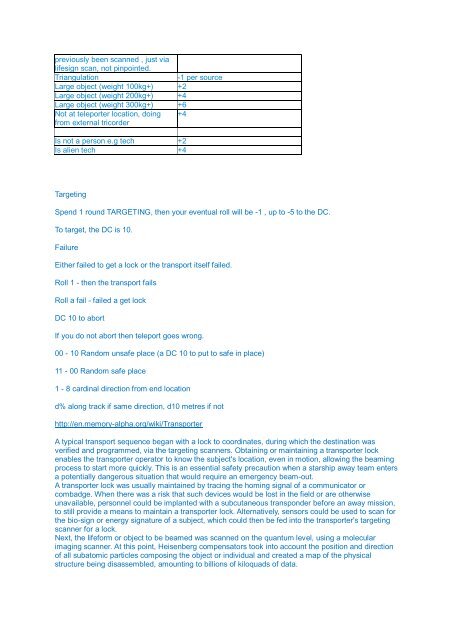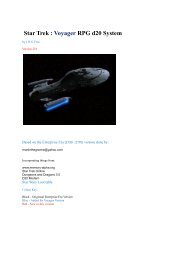You also want an ePaper? Increase the reach of your titles
YUMPU automatically turns print PDFs into web optimized ePapers that Google loves.
previously been scanned , just via<br />
lifesign scan, not pinpointed.<br />
Triangulation<br />
-1 per source<br />
Large object (weight 100kg+) +2<br />
Large object (weight 200kg+) +4<br />
Large object (weight 300kg+) +6<br />
Not at teleporter location, doing +4<br />
from external tricorder<br />
Is not a person e.g tech +2<br />
Is alien tech +4<br />
Targeting<br />
Spend 1 round TARGETING, then your eventual roll will be -1 , up to -5 to the DC.<br />
To target, the DC is 10.<br />
Failure<br />
Either failed to get a lock or the transport itself failed.<br />
Roll 1 - then the transport fails<br />
Roll a fail - failed a get lock<br />
DC 10 to abort<br />
If you do not abort then teleport goes wrong.<br />
00 - 10 Random unsafe place (a DC 10 to put to safe in place)<br />
11 - 00 Random safe place<br />
1 - 8 cardinal direction from end location<br />
d% along track if same direction, d10 metres if not<br />
http://en.memory-alpha.org/wiki/Transporter<br />
A typical transport sequence began with a lock to coordinates, during which the destination was<br />
verified and programmed, via the targeting scanners. Obtaining or maintaining a transporter lock<br />
enables the transporter operator to know the subject's location, even in motion, allowing the beaming<br />
process to start more quickly. This is an essential safety precaution when a starship away team enters<br />
a potentially dangerous situation that would require an emergency beam-out.<br />
A transporter lock was usually maintained by tracing the homing signal of a communicator or<br />
combadge. When there was a risk that such devices would be lost in the field or are otherwise<br />
unavailable, personnel could be implanted with a subcutaneous transponder before an away mission,<br />
to still provide a means to maintain a transporter lock. Alternatively, sensors could be used to scan for<br />
the bio-sign or energy signature of a subject, which could then be fed into the transporter's targeting<br />
scanner for a lock.<br />
Next, the lifeform or object to be beamed was scanned on the quantum level, using a molecular<br />
imaging scanner. At this point, Heisenberg compensators took into account the position and direction<br />
of all subatomic particles composing the object or individual and created a map of the physical<br />
structure being disassembled, amounting to billions of kiloquads of data.



